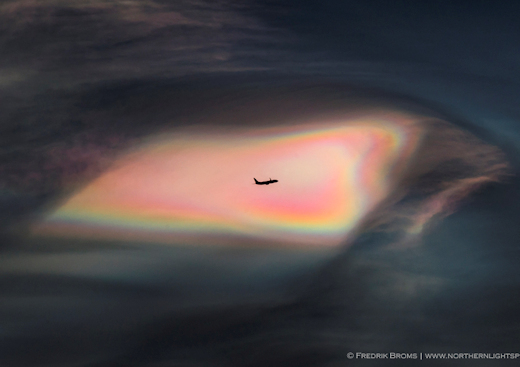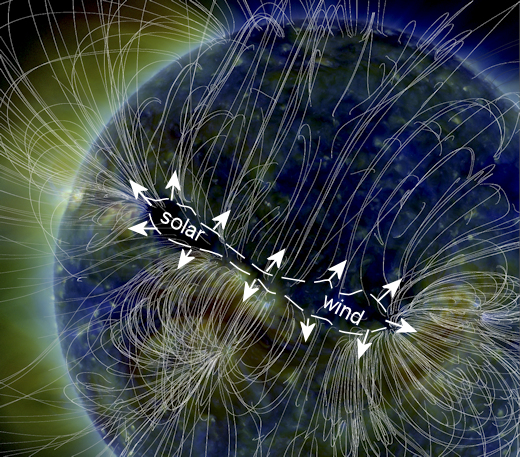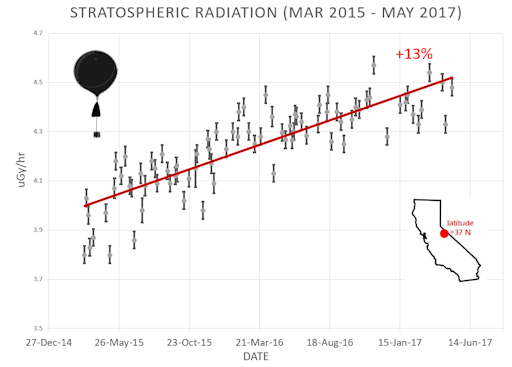All-inclusive Northern Lights trips in Tromsø, Norway. Small groups, big experiences! Highly qualified guides ensure unique and unforgettable adventures with a personal touch. Visit Explore the Arctic | | |
THE DECEMBER SOLSTICE: Thursday, Dec. 21st, will be the shortest day of 2017 for anyone living north of the equator. It's the December solstice, when the sun reaches its lowest point on the celestial sphere. Northern winter begins at 11:28 a.m. EST. Because seaons are reversed on opposite sides of the equator, southern summer beings at the same time. Happy Solstice!
POLAR STRATOSPHERIC CLOUDS: The stratosphere above the Arctic Circle is getting cold ... very cold. That's the only way to explain these colorful clouds that materialized over Kvaløya, Norway, on Dec. 20th:

These are polar stratospheric clouds (PSCs), and they require temperatures around -85ºC to form.
"Today, heavy rainclouds and a bitter wind greeted the people of Tromsø in northern Norway when they woke up. But all of a sudden, the clouds parted and the sky cracked open to reveal an absolutely stunning display of stratospheric clouds high above the ordinary gray rainclouds," says photographer Fredrik Broms. "Seldom have I seen PSCs with such vivid colours as today."
The stratosphere is extremely dry, which makes it hard for clouds of any type to form. Only when the air up there becomes extremely cold do widely-spaced water molecules coalesce to form ice crystals--the "stuff" of PSCs. High-altitude sunlight shining through these ice particles produces the clouds' characteristic bright iridescent colors.
Today's sighting in Norway and a related sighting in Sweden marks the beginning of the 2017-18 winter season for polar stratospheric clouds. Stay tuned for more.
Realtime Space Weather Photo Gallery
A GASH IN THE SUN'S ATMOSPHERE: Magnetic maps of the sun's atmosphere reveal a long gash, more than 700,000 km long, where solar wind may be spraying into the solar system. This image of the structure is based on data from NASA's Solar Dynamics Observatory:

Astronomers call this a "coronal hole"--a region when the sun's magnetic field opens up and allows solar wind to escape. Coronal holes are common, appearing every few weeks. This one, however, is uncommonly long and narrow. A fan-shaped spray of gaseous material flowing from the gash could reach our planet as early as Dec. 23rd. Arctic sky watchers should be alert for auroras when the solar wind arrives. Free: Aurora Alerts.
Realtime Aurora Photo Gallery
STUDENT CHRISTMAS SPECIAL: Christmas shopping for a young scientist? Consider this: For the holiday season only, we're reducing the cost of payload space on Earth to Sky Calculus balloons from $500 to only $299. Buy a ticket to space before Dec. 25th and your student can send an experiment, photo, or keepsake item to the stratosphere, completely supported by an Earth to Sky Calculus launch and recovery team.

This is not only a great Christmas gift, but also a good kickstarter for science fair projects. Experiments will be flown and returned along with video footage, GPS tracking, temperature, pressure, altimetry and radiation data.
To take advantage of the discounted rate, payment must be received before Dec. 25th. However, the flight can take place at any time in the next 12 months.
Conditions: No mammals. Plants and non-pathogenic microbes are allowed. Generally speaking, experiments should weigh less than a few hundred grams and occupy a volume less than that of a school lunchbox. A brainstorming session is included with each certificate. Dr. Tony Phillips and other members of the Earth to Sky team will chat with recipients to help them craft an experiment that will work in the harsh environment of the stratosphere.
Far Out Gifts: Earth to Sky Store
All proceeds support hands-on STEM education
Every night, a network of
NASA all-sky cameras scans the skies above the United States for meteoritic fireballs. Automated software maintained by NASA's Meteoroid Environment Office calculates their orbits, velocity, penetration depth in Earth's atmosphere and many other characteristics. Daily results are presented here on Spaceweather.com.
On Dec. 20, 2017, the network reported 29 fireballs.
(24 sporadics, 3 December Leonis Minorids, 1 Geminid, 1 December Hydrid)

In this diagram of the inner solar system, all of the fireball orbits intersect at a single point--Earth. The orbits are color-coded by velocity, from slow (red) to fast (blue). [Larger image] [movies]
Potentially Hazardous Asteroids (
PHAs) are space rocks larger than approximately 100m that can come closer to Earth than 0.05 AU. None of the known PHAs is on a collision course with our planet, although astronomers are finding
new ones all the time.
On December 20, 2017 there were 1872 potentially hazardous asteroids.
 |
Recent & Upcoming Earth-asteroid encounters: | Asteroid | Date(UT) | Miss Distance | Velocity (km/s) | Diameter (m) |
| 2015 XX169 | 2017-Dec-14 | 9.7 LD | 6.3 | 11 |
| 2006 XY | 2017-Dec-14 | 3.4 LD | 4.9 | 56 |
| 2017 XY2 | 2017-Dec-15 | 4.5 LD | 8.2 | 14 |
| 2017 XK1 | 2017-Dec-15 | 6.2 LD | 12.2 | 32 |
| 2017 XR2 | 2017-Dec-15 | 12.2 LD | 9.4 | 44 |
| 2017 XD2 | 2017-Dec-15 | 14.4 LD | 12.3 | 69 |
| 2017 VT14 | 2017-Dec-17 | 3.8 LD | 10.4 | 84 |
| 2017 XT60 | 2017-Dec-17 | 8 LD | 7 | 12 |
| 2017 XW60 | 2017-Dec-18 | 5.2 LD | 8.8 | 9 |
| 2017 XW61 | 2017-Dec-18 | 3.1 LD | 11.7 | 28 |
| 2017 XX61 | 2017-Dec-18 | 8.2 LD | 15.6 | 17 |
| 2017 XY61 | 2017-Dec-19 | 2.5 LD | 13.9 | 20 |
| 2011 YD29 | 2017-Dec-19 | 17.6 LD | 7.7 | 20 |
| 2017 WX12 | 2017-Dec-21 | 10 LD | 11.4 | 136 |
| 2017 XR60 | 2017-Dec-21 | 13 LD | 6.2 | 49 |
| 2017 XQ60 | 2017-Dec-21 | 13.4 LD | 15.7 | 49 |
| 2017 YE | 2017-Dec-22 | 2.9 LD | 4.7 | 7 |
| 2017 TS3 | 2017-Dec-22 | 18.1 LD | 10.2 | 137 |
| 418849 | 2017-Dec-22 | 15.3 LD | 17.4 | 257 |
| 2015 YQ1 | 2017-Dec-22 | 17.3 LD | 11.1 | 9 |
| 2017 WZ14 | 2017-Dec-24 | 7.6 LD | 4.9 | 33 |
| 2017 XG1 | 2017-Dec-29 | 16.4 LD | 9.9 | 38 |
| 2017 QL33 | 2017-Dec-30 | 13.3 LD | 8.2 | 191 |
| 2017 YD | 2018-Jan-01 | 19 LD | 4.1 | 30 |
| 2015 RT1 | 2018-Jan-02 | 19.7 LD | 9 | 30 |
| 2017 XT61 | 2018-Jan-08 | 11.4 LD | 10.8 | 83 |
| 2004 FH | 2018-Jan-10 | 20 LD | 8.5 | 26 |
| 306383 | 2018-Jan-22 | 14.4 LD | 17.4 | 178 |
| 2002 CB19 | 2018-Feb-02 | 10.5 LD | 15.6 | 36 |
| 276033 | 2018-Feb-04 | 11 LD | 34 | 646 |
| 2015 BN509 | 2018-Feb-09 | 12.9 LD | 17.7 | 257 |
| 1991 VG | 2018-Feb-11 | 18.4 LD | 2.1 | 7 |
| 2014 WQ202 | 2018-Feb-11 | 15.1 LD | 19.8 | 62 |
Notes: LD means "Lunar Distance." 1 LD = 384,401 km, the distance between Earth and the Moon. 1 LD also equals 0.00256 AU. MAG is the visual magnitude of the asteroid on the date of closest approach. | | Cosmic Rays in the Atmosphere |
Readers, thank you for your patience while we continue to develop this new section of Spaceweather.com. We've been working to streamline our data reduction, allowing us to post results from balloon flights much more rapidly, and we have developed a new data product, shown here:

This plot displays radiation measurements not only in the stratosphere, but also at aviation altitudes. Dose rates are expessed as multiples of sea level. For instance, we see that boarding a plane that flies at 25,000 feet exposes passengers to dose rates ~10x higher than sea level. At 40,000 feet, the multiplier is closer to 50x. These measurements are made by our usual cosmic ray payload as it passes through aviation altitudes en route to the stratosphere over California.
What is this all about? Approximately once a week, Spaceweather.com and the students of Earth to Sky Calculus fly space weather balloons to the stratosphere over California. These balloons are equipped with radiation sensors that detect cosmic rays, a surprisingly "down to Earth" form of space weather. Cosmic rays can seed clouds, trigger lightning, and penetrate commercial airplanes. Furthermore, there are studies ( #1, #2, #3, #4) linking cosmic rays with cardiac arrhythmias and sudden cardiac death in the general population. Our latest measurements show that cosmic rays are intensifying, with an increase of more than 13% since 2015:

Why are cosmic rays intensifying? The main reason is the sun. Solar storm clouds such as coronal mass ejections (CMEs) sweep aside cosmic rays when they pass by Earth. During Solar Maximum, CMEs are abundant and cosmic rays are held at bay. Now, however, the solar cycle is swinging toward Solar Minimum, allowing cosmic rays to return. Another reason could be the weakening of Earth's magnetic field, which helps protect us from deep-space radiation.
The radiation sensors onboard our helium balloons detect X-rays and gamma-rays in the energy range 10 keV to 20 MeV. These energies span the range of medical X-ray machines and airport security scanners.
The data points in the graph above correspond to the peak of the Reneger-Pfotzer maximum, which lies about 67,000 feet above central California. When cosmic rays crash into Earth's atmosphere, they produce a spray of secondary particles that is most intense at the entrance to the stratosphere. Physicists Eric Reneger and Georg Pfotzer discovered the maximum using balloons in the 1930s and it is what we are measuring today.
| | The official U.S. government space weather bureau |
| | The first place to look for information about sundogs, pillars, rainbows and related phenomena. |
| | Researchers call it a "Hubble for the sun." SDO is the most advanced solar observatory ever. |
| | 3D views of the sun from NASA's Solar and Terrestrial Relations Observatory |
| | Realtime and archival images of the Sun from SOHO. |
| | from the NOAA Space Environment Center |
| | fun to read, but should be taken with a grain of salt! Forecasts looking ahead more than a few days are often wrong. |
| | from the NOAA Space Environment Center |
| | the underlying science of space weather |
 | Reviews here can help you to pick up best memory foam mattresses. |
| | These links help Spaceweather.com stay online. Thank you to our supporters! |
| | | | | | |

